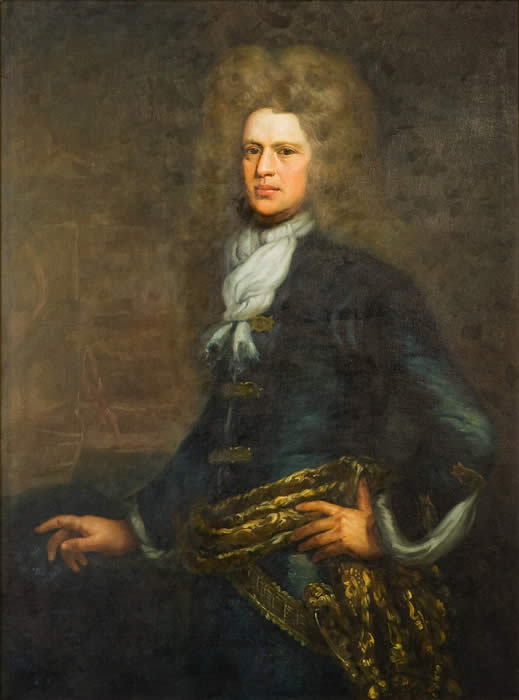The Admiral
 Admiral Sir John Balchin Admiral Sir John Balchin |
Admiral Sir John Balchin (also spelled Balchen) was one of the most respected and longest-serving officers in Royal Naval history. He dedicated 58 years of service to king and country, sailing the waters of the West Indies, the Baltic, Mediterranean and English Channel on 13 different warships.
Balchin was promoted to Rear Admiral in 1728, Vice-Admiral six years later, and in August 1743 became Admiral of the White, the second highest naval position. Twice captured by the French and twice exonerated by courts martial, the Admiral's illustrious career culminated in 1744, when, aged 74, he was called out of retirement to assume active command of the First Rate flagship HMS Victory.
Balchin began his rise to prominence after being appointed captain of the Virgin in 1697. From there he served as captain and later commander of the Firebrand (1697), Vulcan (1702), Adventure and Chester (1703-1707), Gloucester (1709), Colchester (1710-1715), Diamond (1715), Orford (1716), Shrewsbury (1718), Monmouth (1719) and Ipswich (1722-1725).
In April 1744, the Admiral was appointed Governor of Greenwich Naval Hospital and was knighted by King
George II for his long-standing service to his country. His new appointment was supposed to be an honourable retirement from the active list.
Yet in July 1744, Balchin was called out of retirement to command the Royal Navy's premiere flagship HMS Victory, armed with a ferocious set of up to 110 bronze cannon. The Admiral was required to rescue the Mediterranean victual convoy blockaded down the River Tagus by the Brest fleet. If these vital supplies failed to reach the Mediterranean fleet, England was at risk of losing the War of the Austrian Succession.
By late August the Victory accompanied by a large fleet of ships, arrived at the River Tagus in Lisbon, immediately
liberated the convoy and escorted it to Gibraltar. The French squadron of 12 ships retreated to Cadiz with Balchin in hot
pursuit and blocking the fleet in port.
On his voyage home, Balchin set sail from the coast of Galicia on 28 September, but shortly after entering the English
Channel a fierce storm arose, which dispersed the fleet. All of the sails safely reached England with the sole exception of the Victory. Britain's flagship was lost with about 1,100 sailors, plus marines and 50 volunteers drawn
from the noblest families of England. The disaster also took the life of the Admiral,
tragically ending one of the most remarkable naval careers in British history.
The loss of Britain's greatest naval deterrent and one of its most distinguished admirals sent shockwaves across the land. The tragedy was recognised by a 10-foot marble monument erected in Sir John's memory in the northern transept of Westminster Abbey which includes an evocative bas-relief showing HMS Victory dismasted and about to capsize in a raging sea.
